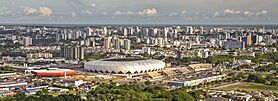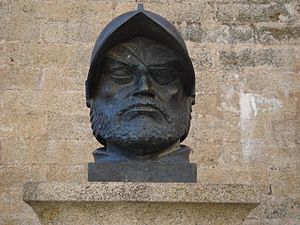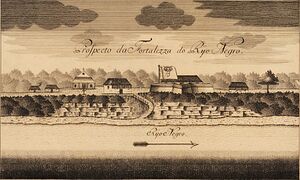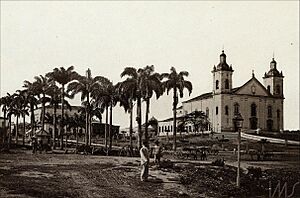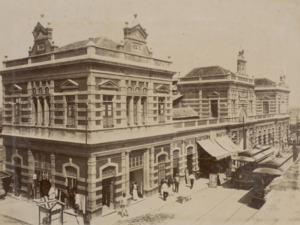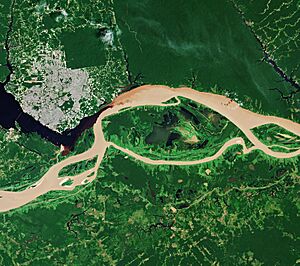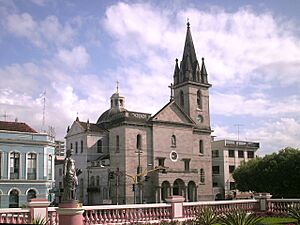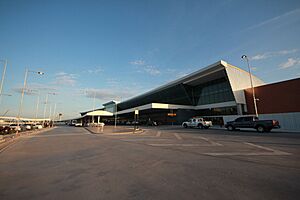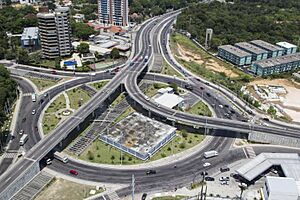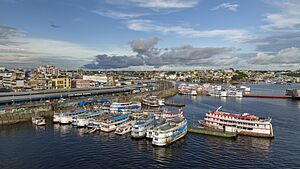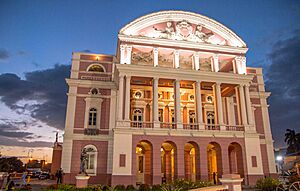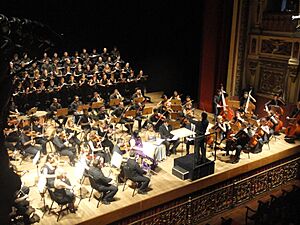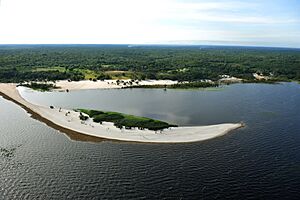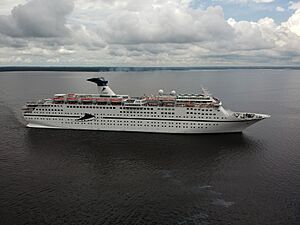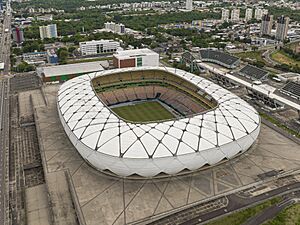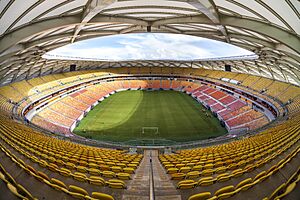Manaus facts for kids
Quick facts for kids
Manaus
|
|||
|---|---|---|---|
| Município de Manaus Municipality of Manaus |
|||
|
Skyline with the Arena da Amazônia
Amazon Theatre
Port of Manaus
Church of Saint Sebastian
Rio Negro Bridge
Municipal Clock Tower
Adrianópolis
Ponta Negra
|
|||
|
|||
| Nickname(s):
A Paris dos Trópicos (The Paris of the Tropics); Mãe dos Deuses (Mother of the Gods)
|
|||
| Motto(s):
"A metrópole da Amazônia" (The metropolis of the Amazon)
|
|||
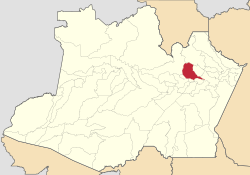
Location in the state of Amazonas
|
|||
| Country | |||
| Region | North | ||
| State | Amazonas | ||
| Founded | October 24, 1669 | ||
| Area | |||
| • Metropolis | 11,401.092 km2 (4,401.97 sq mi) | ||
| • Urban | 427 km2 (165 sq mi) | ||
| Elevation | 92 m (302 ft) | ||
| Population
(2022)
|
|||
| • Metropolis | 2,063,689 (7th) | ||
| • Density | 181.01/km2 (450.29/sq mi) | ||
| • Metro | 2,676,936 (11th) | ||
| Demonym(s) | Manauara, Manauense | ||
| GDP (PPP, constant 2015 values) | |||
| • Year | 2023 | ||
| • Total (Metro) | $37.4 billion | ||
| • Per capita | $16,400 | ||
| Time zone | UTC−4 (AMT) | ||
| Postal code |
69000-001 to 69099-999 and 69400-000 to 69899-999
|
||
| Area code | +55 (92) | ||
| HDI (2010) | 0.737 – high | ||
Manaus is the capital and largest city in the Brazilian state of Amazonas. It is the seventh-largest city in Brazil, with over 2 million people living there in 2022. Manaus is located in the eastern part of the state, right where the Negro and Amazon rivers meet. It's one of only two cities in the Amazon rainforest with more than a million people.
The city started as a fort called São José do Rio Negro in 1669. In 1832, it became a town named "Manaus," which comes from the native Manaós people. This name means "Mother of the Gods." On October 24, 1848, it officially became a city.
Manaus is in the middle of the Amazon rainforest. It's a very important place for scientific studies about the Amazon. It was once called the Heart of the Amazon and City of the Forest. Today, its main economy comes from the Industrial Park of Manaus, which is a special Free Economic Zone. The city has a free port and an international airport. Factories here make electronics, chemicals, and soap. Manaus also exports things like Brazil nuts, rubber, and jute. You can find a cathedral, an opera house, and zoological and botanical gardens in the city.
The Solimões and Negro rivers meet just east of Manaus. They flow side-by-side without mixing for a while before forming the Amazon River. In the late 1800s, Manaus became very rich because of the rubber boom. This wealth earned it the nickname the Paris of the Tropics. Many rich European families moved here, bringing their love for European art, architecture, and culture. Manaus was also one of the cities that hosted games for the 2014 World Cup and the 2016 Summer Olympics.
Contents
- What Does the Name Manaus Mean?
- A Look at Manaus's Past
- Exploring Manaus's Geography
- How Many People Live in Manaus?
- Manaus's Economy
- Learning and Innovation in Manaus
- Getting Around Manaus
- Fun Events and Holidays in Manaus
- Places to See and Things to Do in Manaus
- Sports in Manaus
- Manaus's Global Connections
- Famous People from Manaus
- See also
What Does the Name Manaus Mean?
The name Manaus comes from the native people called Manaós. This word means Mother of the Gods.
A Look at Manaus's Past
How Manaus Began
European people started settling in the Manaus area in 1499. The Spanish first arrived at the mouth of the Amazon River. Later, in 1668–1669, the Portuguese built the Fort of São José da Barra do Rio Negro. They built it to protect their land from the Dutch. The fort was made of rock and clay and had four cannons. Many native people lived nearby and helped build it.
Because the population grew, missionaries built a chapel in 1695. It was for Nossa Senhora da Conceição (Our Lady of the Conception), who became the city's patron saint. In 1755, the area became a captaincy, but the main city moved to Lugar de Barra in 1791. This spot was important because it was where the Rio Negro and Amazon Rivers met. On November 13, 1832, Lugar da Barra became a town called Manaus. On September 4, 1856, it officially got its current name, "Manaus."
The Rubber Boom Era
Manaus was at the heart of the Amazon's rubber boom in the late 1800s. For a while, it was one of the richest cities in the world. Rubber barons, who made their money from rubber, spent huge amounts on fancy things. They built a magnificent opera house with marble, glass, and crystal from Europe. This opera house cost a lot of money.
However, the rubber boom ended suddenly. This happened when rubber tree seeds were taken from the Amazon and grown on plantations in Southeast Asia. Brazil lost its control over rubber production. Many people left Manaus, and the city became poor. The opera house was mostly closed for nearly 90 years. It reopened in 1997 and now hosts performers from all over the world.
Manaus's Free Trade Zone
In the 1960s, the Brazilian government wanted to help the Amazon region grow. They created the Manaus Free Trade Zone in 1967. This zone offered special tax benefits to companies. Many national and international businesses invested in Manaus because of these benefits. This led to a huge increase in the city's population and economy.
Recent Events in Manaus
Manaus was one of the host cities for the 2014 FIFA World Cup. It also hosted some Olympic football games in 2016. It was the only World Cup host city in the Amazon rainforest. In January 2017, there was a large prison riot that started in Manaus.
During the COVID-19 pandemic in Brazil, many people in Manaus got sick. Later, a new variant of the virus caused another outbreak in early 2021.
Exploring Manaus's Geography
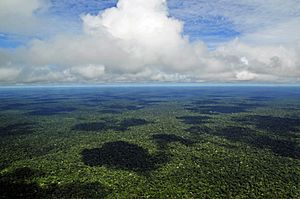
Manaus is the largest city in northern Brazil. It covers an area of about 11,401 square kilometers. It is next to cities like Presidente Figueiredo and Iranduba.
The Amazon Rainforest
Manaus is located in the middle of the Amazon rainforest. The Amazon is the largest and most diverse tropical rainforest in the world. It has more than half of the planet's remaining rainforests. Over one-third of all species in the world live in the Amazon rainforest.
Green Spaces in the City
Even though Manaus is in the Amazon, it has many developed areas. However, it also has important green spaces:
- Mindu Park: This park was created in 1989 and is one of the city's largest and most visited.
- Bilhares Park: Established in 2005, it's in the south-central part of Manaus.
- Sumaúma State Park: This is a state park in northern Manaus. It is the smallest state park in the Brazilian Amazon.
- Castanheiras Pied Tamarin Wildlife Refuge: Created in 1982, this refuge protects the endangered pied tamarin monkey.
- Adolfo Ducke Forest Reserve: This large biological reserve was set up in 1963. It is managed by the National Institute for Amazon Research (INPA).
- Anavilhanas National Park: Part of this large conservation area is near Manaus.
- Rio Negro Left Bank Environmental Protection Area: A large conservation area created in 1995.
- Tupé Sustainable Development Reserve: This reserve is about 25 km west of the city.
- Rio Negro State Park South Section: Located about 40 km northwest of the city by boat.
Manaus's Climate
Manaus has a tropical monsoon climate. This means it's hot and humid all year round. The average temperature is about 27.4°C. It gets a lot of rain, around 2300 mm each year. The seasons are mostly defined by rain: July to September is drier, and December to May is very rainy. Thunderstorms happen often, especially in summer.
Because Manaus is close to the equator, it's always warm. There are no cold winter days. Sometimes, very cold air from southern Brazil can reach the city, causing temperatures to drop to about 18°C. The nearby forest helps keep the city humid and prevents extreme heat.
The highest temperature ever recorded in Manaus was 39°C in 2015. The lowest was 12°C in 1989. In 2009, there was a case of acid rain in Manaus. This was caused by air pollution from burning and car emissions.
How Many People Live in Manaus?
In 2019, about 2,182,763 people lived in Manaus. The larger metropolitan area had about 2,676,936 people. Most of the population lives in the North and East parts of the city. The Nova Cidade neighborhood in the north is the most populated, with over 260,000 residents.
Manaus is the seventh-largest city in Brazil. Its population has grown faster than the national average.
Different Backgrounds in Manaus
The people of Manaus come from many different backgrounds. A study in 2013 showed that the ancestry of Manaus residents is about 45.9% European, 37.8% Native American, and 16.3% African.
| Racial composition | 2022 |
|---|---|
| Mixed | 69.6% |
| White | 23.7% |
| Black | 5.6% |
| Amerindian | 0.9% |
| Asian | 0.2% |
Religions in Manaus
Manaus has been influenced by Catholicism since European times. Most people in Manaus are Catholic. However, there are also many different Protestant churches. Other religions like Judaism and Islam are also practiced. The main Catholic church is the Catedral Metropolitana Nossa Senhora da Conceição.
Many Protestant faiths are growing in the city, especially in the outer areas. The Church of Jesus Christ of Latter-day Saints also has a large presence, with a temple built in Manaus.
Manaus's Economy
Manaus has the sixth-largest economy in Brazil. In 2014, its economy was worth R$67.5 billion. While rubber was once very important, its role has decreased. Today, fish, wild fruits like Açaí and Cupuaçu, and Brazil nuts are important for trade.
The city also has industries for petroleum refining, soap making, and chemicals. Over the last few decades, special government investments and tax benefits have made the area a major industrial center. This is called the Free Economic Zone of Manaus.
Many mobile phone companies like LG, Nokia, and Samsung have factories in Manaus. Other major electronics manufacturers also have plants here. Manaus also has its own sport utility vehicle manufacturer, Amazon Veiculos.
Learning and Innovation in Manaus
Manaus is a hub for learning, science, and technology. It has several research centers and universities:
- Federal University of Amazonas (UFAM)
- University of the State of Amazonas (UEA)
- National Institute of Amazonian Research (INPA)
- Sidia Institute of Science and Technology
- Federal Institute of Education, Science and Technology
- And many other colleges and universities.
Getting Around Manaus
Airports
Eduardo Gomes International Airport is the main airport for Manaus. It has two terminals for passengers and three for cargo. It's Brazil's third-largest airport for moving goods. This is because it handles a lot of imports and exports for the Manaus Industrial Complex.
The airport was updated for the 2014 FIFA World Cup. It has daily international flights to places like Miami and Panama City. It also has direct flights to all major airports in Brazil.
Manaus also has the Manaus Air Force Base, which is important for the Brazilian Air Force. There's also Flores Airport, used for smaller planes and helicopters.
Highways
Manaus has two main federal highways. The BR-174 goes north, connecting Manaus to Boa Vista and then to Venezuela.
The BR-319 goes south towards Porto Velho. However, to use this highway, you need to take a ferry across the Rio Negro and Amazon River. After that, much of the highway is not paved and cannot be used. Because of this, most travel to and from Manaus is by boat or plane, except for trips to Roraima.
The two main state highways are the AM-010 and AM-070. The AM-010 goes east to Itacoatiara, Amazonas. The AM-070 starts across the new Rio Negro Bridge and goes south to Manacapuru. Both of these roads are paved and open all year.
Port
Ships dock at the main Port of Manaus right in downtown. Many mobile phone and electronics companies have factories in the port area. Major exports from the port include Brazil nuts, chemicals, petroleum, and forest products.
Taxis and Buses
Manaus has white taxis that you can stop anywhere. They use meters, but sometimes they might not. There are also 'special' black taxis that are usually nicer and charge a fixed price.
The city has a large bus system that goes to most places, including popular tourist spots. You can use a simple website to plan your bus routes.
Fun Events and Holidays in Manaus
Manaus has many festivals throughout the year. The Manaus carnival happens in late February or early March. It includes traditional parades and samba dancing at the Sambódromo.
May is a great time to visit because of the Ponta Negra Music Festival and the Amazonas de Opera Festival. The Opera Festival lasts about three weeks at the Amazon Theatre. The Floclorico do Amazonas (Amazonas Folklore Festival) in June is a big event with lots of folk dancing and music. It ends with a procession of hundreds of riverboats honoring the patron saint of fishermen.
October 24 is Manaus's anniversary, and it's always a big party with fireworks. In November, there's the week-long Amazonas Film Festival, which often shows films about ecology and human relationships.
- February: Amazonas Carnival
- May: Ponta Negra's Music Festival, Amazonas Opera Festival
- June: Amazonas Folklore Festival, São Pedro Fluvial Procession
- July: Amazonas Jazz Festival
- October 24: Anniversary of Manaus
- December 31: Ponta Negra's New Year's Eve Party
Places to See and Things to Do in Manaus
Manaus is in the Amazon rainforest, so many tourists come to see the amazing wildlife. It's also home to the pied tamarin, one of Brazil's most endangered monkeys.
You can take boat tours to see the Meeting of the Waters. This is where the dark water of the Negro River meets the muddy brown water of the Solimões River. They flow side-by-side for about 9 km without mixing! You can also explore river banks, swim in calm lakes, or walk in the lush forest.
About 18 km from downtown is Ponta Negra beach. It's a popular spot for nightlife. A fancy hotel is located there, and its zoo and orchid greenhouse are open to the public.
The Mercado Adolpho Lisboa, built in 1882, is the city's oldest market. It sells fruits, vegetables, and especially fish. It looks like the Les Halles market in Paris. Other historical places include the customs building and the Justice Palace, next to the Opera House.
Manaus also has many large parks with preserved native forests, like the Bosque da Ciência and Parque do Mindú. The largest urban forest in the world is inside the Federal University of Amazonas.
Manaus has several large shopping malls, like Manauara Shopping and Amazonas Shopping Center. These malls usually have big food courts and movie theaters.
Culture in Manaus
Manaus has a lively cultural scene. Throughout the year, there are Opera, Theater, Jazz, and Cinema festivals. There's also Boi Manaus, a big celebration of Northern Brazilian culture with Boi-Bumbá music.
The Famous Amazonas Opera House
The Amazonas Opera House opened in 1896. It has 700 seats and was built with bricks from Europe, French glass, and Italian marble. Many famous opera and theater groups, as well as international orchestras, have performed here. The theater is home to the Amazonas Philharmonic orchestra.
Parks for Fun and Nature
Ponta Negra Cultural, Sport, and Leisure Park Ponta Negra beach is about 13 km from downtown Manaus. It's a very important tourist spot. It also has an amphitheater that can hold 15,000 people.
Adolpho Ducke Botanical Garden The Adolpho Ducke Botanical Garden is inside a 100 square kilometer ecological reserve. It has a huge number of different plants and animals.
Mindu Municipal Park
This park is in an urban area. It was created in 1992 to protect nature. It covers 330,000 square meters of forest and is used for science, education, culture, and tourism. It's one of the last places where the pied tamarin lives. This monkey only lives in the Manaus region and is in danger of extinction. You can walk through different ecosystems in the park. It also has an amphitheater, gardens with medicinal herbs, and an orchid nursery.
Public Swimming Spots
The Tarumã, Tarumãzinho, and Cachoeira das Almas bayous (small river branches) are popular places for people to relax on weekends. Manaus has several public swimming areas that are being updated. There are also many private clubs you can visit.
The Meeting of Waters

The Meeting of Waters is a natural wonder. It's where the dark water of the Rio Negro and the muddy brown water of the Solimões River come together to form the Amazonas River. For about 6 km, the two rivers flow side-by-side without mixing! This happens because they have different speeds, amounts of water, and densities. The Negro River flows slowly at about 2 km/h, while the Solimões River flows faster, between 4 to 6 km/h.
CIGS Zoo
The CIGS Zoo is open to the public. It's managed by the Brazilian Army and has about 300 different animals from the Amazon.
Beaches and Waterfalls
To visit many beaches and parks near the city, you often need to take a boat. The beaches appear when the river water level drops, usually from August to November. When the river rises again in December, the water covers the sand and woods.
The Paricatuba Waterfall is on the Rio Negro River. It's surrounded by lots of plants. You can reach it by boat. The best time to visit is from August to February. Love Cascade is another waterfall with clear water, accessible only by boat and then a hike through the forest.
Tupé Beach is about 34 km from Manaus. It's popular on holidays and weekends and can only be reached by boat. Moon Beach is about 23 km from Manaus, also on the Rio Negro. It's shaped like a crescent moon and has unique plants. Lion Waterfall is located on the AM-010 highway.
Sports in Manaus
Football (Soccer)
Manaus has a strong football history. The most successful club is Nacional Futebol Clube, founded in 1913. They have won the state championship 40 times, more than any other club in Amazonas.
Other important clubs include Atlético Rio Negro Clube, National Fast Club, and São Raimundo EC. Manaus Futebol Clube, founded in 2013, also competes in national leagues.
Manaus and the 2014 FIFA World Cup
Manaus was chosen in 2009 to host games for the 2014 FIFA World Cup. The city made many improvements for the event, including a new airport and better roads. The communications were also upgraded with 4G networks.
The old stadium, Vivaldão, was replaced by the new 44,000-seat Arena Amazônia for the World Cup. Manaus hosted four World Cup matches. Because of the intense heat and humidity, one match even had the World Cup's first-ever official water break!
Brazilian Jiu-Jitsu
Manaus is known for producing many world-champion Brazilian jiu-jitsu black belts and mixed martial artists. Champions like Fredson Paixão, Wallid Ismail, and José Aldo come from Manaus. Brazilian jiu-jitsu is a key part of MMA (mixed martial arts). José Aldo is a famous UFC fighter who became the UFC Featherweight champion.
Manaus's Global Connections
Sister Cities Around the World
Manaus is connected to many cities around the world through "sister city" partnerships. These connections help promote cultural exchange and friendship.
|
|
Famous People from Manaus
- José Aldo, UFC featherweight champion
- Antônio Pizzonia, Formula 1 driver
- Daynara de Paula, Brazilian swimmer
- Fredson Paixão, 4-time BJJ world champion
- Diego Brandão, Ultimate Fighter winner
- Vinicius Cantuária, bossa nova musician
- Bibiano Fernandes, jiu-jitsu competitor
- Marcelo Gomes, principal dancer
- Sandro Viana, Brazilian sprinter
- Wallid Ismail, jiu-jitsu black belt
- Francisco Lima Govinho, football player
- Priscilla Meirelles, Miss Earth 2004
- Cristiano Moraes Oliveira, football player
- Fábio Pereira de Oliveira, football player
- Jefferson Peres, politician
- Eliana Printes, MPB singer
- Larissa Ramos, Miss Earth 2009
- Raimar, footballer
- Eduardo Piccinini, swimmer
- Saulo Ribeiro, jiu-jitsu world champion
- Xande Ribeiro, jiu-jitsu world champion
- Malvino Salvador, actor
- Cláudio Santoro, conductor and composer
- Ronaldo Souza, jiu-jitsu world champion
See also
 In Spanish: Manaus para niños
In Spanish: Manaus para niños


